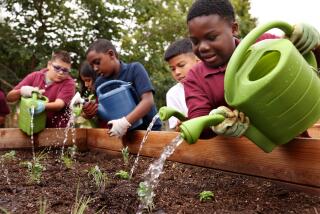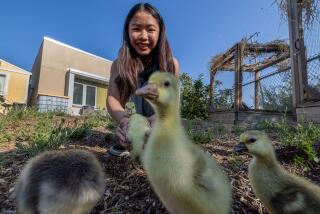Students Give School Salad Bar an A
It’s high noon for the fifth-graders at Juanamaria Elementary School in east Ventura, and it’s time for tough choices.
Sloppy Joes or salad bar?
It’s a no-brainer for 10-year-old Candace Robledo, who started piling lettuce, carrots and croutons onto her plate, topping them with a splash of creamy ranch dressing.
“I love the salad bar; it’s so good,” she said last week as she joined a long line of youngsters turning a cold shoulder to the hot sandwich and tater tots. “When there is no salad bar, I just bring my lunch.”
That’s good news for supporters of Juanamaria’s farm-fresh salad bar, a pilot project in the Ventura Unified School District and a component of a schoolwide effort to develop good eating habits and build relationships with Ventura County growers.
Launched last spring, the federally funded program puts a salad bar--made up mostly of locally grown produce--into the Juanamaria cafeteria twice a week.
In the 12 weeks it was offered last school year, cafeteria workers, school employees and parent volunteers helped serve up nearly 4,000 salad bar meals to students in first through fifth grade.
Nearly eight out of 10 students who participated in the school lunch program chose the salad bar over a hot lunch when it was available. And 20% more students bought cafeteria lunches on salad bar days.
After a four-month hiatus, the salad bar was wheeled out again last week. And if it proves to be successful this school year, district officials will consider extending it to other elementary schools.
“You don’t really have to hammer kids over the head with the idea that fruits and vegetables are good for you if you just let them try really good fruits and vegetables,” said PTA Vice President Pat McCart-Malloy, who was instrumental in launching the program. She is one of the parents who volunteer to help students pack the produce onto their plates.
“Kids are smart and they like making choices,” she said. “And we’ve found when you allow them, they’ll make really good choices.”
McCart-Malloy teamed last year with Ojai farmer Jim Churchill to establish the project after learning about a similar program run by the Santa Monica-Malibu Unified School District.
Through his work with the Community Alliance with Family Farmers, Churchill organizes pilot projects that help support local farmers and encourage increased consumption of fresh produce. A four-year grant from the National Farm-to-School Program, based at Occidental College, funds his participation.
Before opening the salad bar for business in March, he and McCart-Malloy visited classrooms and had students sample a variety of fruits and vegetables to determine what the salad bar should offer.
The venture has spun off a range of complementary components, including a renewed emphasis on nutrition education and a school garden, cultivated each year to teach youngsters where their food comes from.
New Market for Many Local Growers
The project also has produced benefits for local farmers, giving them another outlet for their produce at a time when many are being squeezed economically by rising production costs and increased global competition.
“It’s not going to guarantee the future of Ventura County agriculture,” said Churchill, an Ojai Valley tangerine grower. “But if this program catches on, it could be a significant source of income for some growers.”
Salad bars have long been available at Ventura’s high school and middle schools. But Sandy VanHouten, the district’s newly appointed director of child nutrition services, said Juanamaria’s bar also includes educational components.
Watching over the salad bar line last week, VanHouten said one of the main goals is to get students to develop healthy eating habits that will last a lifetime.
Judging by the long line of students waiting to select from such offerings as cucumbers, jicama and table grapes, the program is headed in the right direction.
“We really want them to understand the big picture about food, from start to finish,” VanHouten said. “There are just so many learning opportunities out of something like this. And if you walk around, you’ll see they are actually eating what they put on their plates.”
It was true at the table where fifth-grader Angela Rodriguez, 9, was sitting. Out of a dozen girls, all but one were eating salad. Angela’s plate was piled high with lettuce, broccoli and cottage cheese.
She said she would never fail to eat salad on the days it is offered, not even if the cafeteria was serving its popular Domino’s pizza.
“You can always eat pizza at home,” she said.
That prompted a conversation about whether other cafeteria food could beat out the salad bar. Sloppy Joes? No way, the girls said. Corn dogs? “Ewwwww,” they cried in unison.
“I’d always pick salad, because it’s just healthier,” said Chelena Stiles, another fifth-grader. “Some of the other food is so fattening and so nasty.”
Even though students have shown they welcome the salad bar, other hurdles remain. Because of the preparation necessary to put the salad bar together, the district must bring in additional workers on the days it is offered.
The Juanamaria PTA, the Hansen Trust--which helps support and sustain Ventura County agriculture--and a host of endowments and foundations have donated money to cover costs, which can reach $31,000 a year. The Patagonia Store in Ventura, through Churchill’s prodding, held a fund-raiser for the cause earlier this month, generating $4,000.
Organizers Hope Project Will Pay for Itself
Churchill said one of the main goals now is to make the salad bar so popular that it draws enough additional cafeteria customers that the program eventually pays for itself.
That’s an issue district officials plan to take a close look at this year as they decide whether to continue the program and if they should extend it to other campuses. Officials with the National Farm-to-School Program also plan to take a closer look to see how effective the program is at achieving its goals.
“We’ve learned some things so far. We know kids will eat their vegetables and that we are learning to make good choices in an environment where they have to make a lot of choices,” said Churchill, who spent one day last week at the salad bar pouring dressing.
“And we know this program is extremely popular with kids. We’ve actually made eating salad cool at school.”
More to Read
Sign up for Essential California
The most important California stories and recommendations in your inbox every morning.
You may occasionally receive promotional content from the Los Angeles Times.










